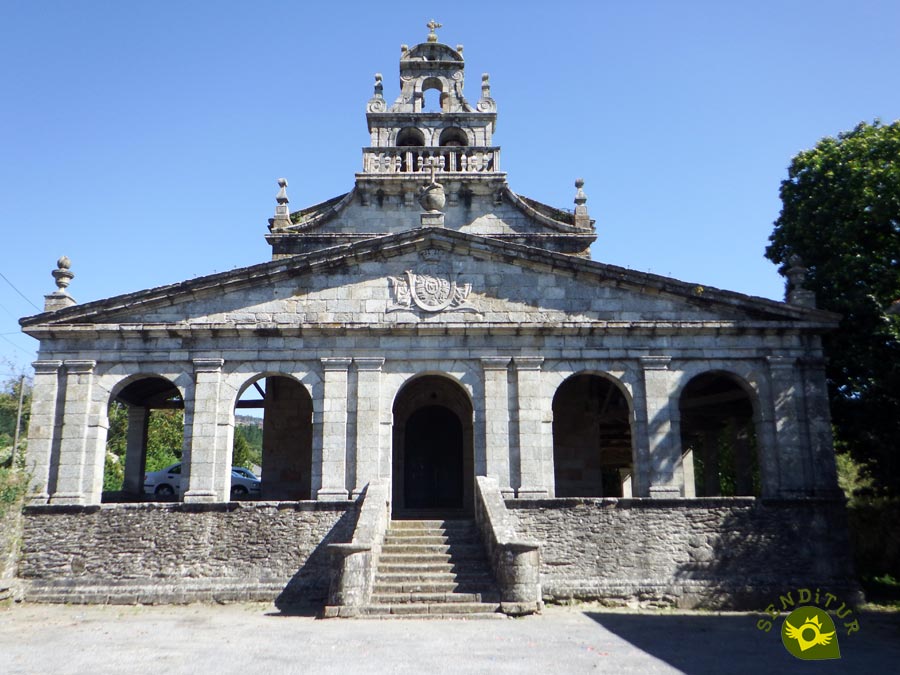It is situated at the foot of the Alto da Bacariza, on the slopes of the Castroverde valley, between meadows and forests of chestnut, oak and pine trees. It is part of the parish of Santa María de Vilabade in the municipality of Castroverde. In a document from the year 1202 a temple is mentioned with the name of Villa Abati, villa of the abbot. It may be the origin of the name and the village of Vilabade, since in the Early Middle Ages it was already known of the existence of a Franciscan monastery that served the pilgrims of the Primitive Way, of which nothing is preserved, and of which in the fourteenth century only its church subsisted on which the present one was built under the auspices of Fernando de Castro, of the house of the Counts of Lemos, in the year 1457. Centuries later, in the 17th century, Diego Osorio Escobar y Lamas, Archbishop of Puebla, Captain General and Viceroy of Mexico, ordered it to be reformed and built the Big House de Vilabade, the Pazo de Abraira-Arana, in the same square as the temple.

In Vilabade, and as the heart of this small village, the parish church of Santa María de Vilabade stands out. It was restored in 1988 and is catalogued as a Monument of National Interest. It is known, and not without reason, as the Cathedral of Castroverde. Its main façade was part of the original structure of the sanctuary, between Romanesque and Gothic. Behind it and on the other side of the Way, comes the water that, channelled, comes from the nearby Fonte do Romeiro, located in the fields adjacent to the Carmen hermitage, a temple that was ordered to be built in the 17th century by the Montenegro-Páramo Osorio Ulloa family, perhaps on top of an earlier sanctuary and which has three coats of arms on its façade. In addition to this sanctuary is related to the disappeared hospital of pilgrims of San Gabriel, in Frontoi de Vilabade, that attended the Franciscans of Vilabade, and of which it seems that there are sure indications of its location. In an angle of the "Cathedral", forming a coquettish square, is the Pazo de Abraira-Arana.

Vilabade celebrates its patron saint festivities in honour of the Virgen del Carmen on the first Sunday in August. Like the rest of the council of Castroverde, it also celebrates the 25th of July in honour of Santiago.
On the first Sunday in August, a traditional pilgrimage is held every year to the chapel of Nuestra Señora del Carmen and its beautiful surroundings, where neighbours and foreigners enjoy a pleasant and festive day in the countryside.
D. Diego Osorio, Viceroy of New Spain, and Bishop of Puebla de Mexico helped with their donations that on June 29, 1669 was created, attached to the chapel of Carmen, the Brotherhood of Carmen that currently has a significant number of brothers. When the Viceroy died, a House of Maidens was created in Vilabade, whose purpose was to take care of the dowry and the marriage of the girls.

Oral history tells that the old Franciscan convent in Vilabade was founded by St. Francis of Assisi himself on the return journey from his pilgrimage to the tomb of the Holy Apostle in the year 1207 where he is said to have been entrusted with the founding of the Franciscan Order. Brother Francisco undertook the Primitive Way from Santiago to San Salvador, Oviedo, and in it he created some convents in strategic places of great peace and beauty.
The accesses that lead to Vilabade are around Castroverde, both at the entrance to the town on the LU-530 at its arrival from O Cádavo and in Castroverde itself, from where one of the roads leading to Vilabade also starts.
The nearby town of Castroverde has a bus stop.
The closest train station to Vilabade is Lugo.
SENDITUR is not responsible for any variation in the information described, as well as for the misuse of its guides and recommends that everyone be responsible and prudent in carrying out the activity. Likewise, we invite you to document yourself with books and specialized guides to complement the information described. From the commitment of SENDITUR with Nature and the respect to the balance of the environment, SENDITUR urges you to travel in a responsible way, with low environmental impact and respecting at all times the Natural, Cultural and Social environment wherever you go. For any suggestion, SENDITUR invites you to send an email to
Continue watching …